|
Theodore Roosevelt and the Dakota Badlands |
 |
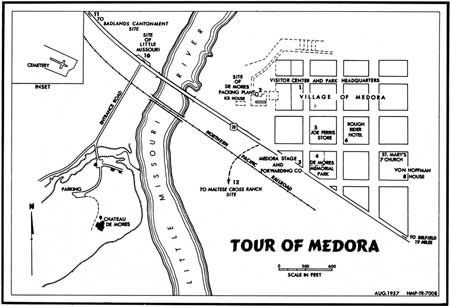
(click on image for an enlargement in a new window)
Features of the Medora Vicinity
The village of Medora was established by the Marquis de Mores in 1883 as a center for his meat packing operations. It was named in honor of his wife. The village contains several historic sites associated with Theodore Roosevelt and his contemporaries.
1. Visitor Center - Theodore Roosevelt National Park. Exhibits on the area's history and natural history tell the story of Theodore Roosevelt and the Badlands. Roosevelt's Maltese Cross Ranch Cabin is located behind the center. Information on his Elkhorn Ranch site and other historical features is available here, as is information on the National Park itself.
2. Site of De Mores Packing Plant. This plant was started in 1883 by the Marquis de Mores for the purpose of shipping processed beef directly from the range to the consumer, thus eliminating "the middleman." Operations ceased after the hard winter of 1886-1887. The building was destroyed by fire in 1907. The chimney ruins are a conspicuous landmark. The site, administered by the State Historical Society of North Dakota, is open to the public.
St. Mary's Church with Von Hoffman house on right.3. Medora State and Forwarding Company served as the office, warehouse, and baggage room for the Marquis de Mores' Medora-Deadwood Stage Line. The coaches traveled the 215-mile route to Deadwood in 36 hours.
4. De Mores Memorial Park was established as a memorial to the Marquis de Mores by his family. A bronze statue of the Marquis is the central feature. Park is maintained by the State Historical Society.
5. Joe Ferris Store. Joe Ferris, a close personal friend of Roosevelt, erected this building in 1885. Roosevelt stayed in an upstairs room in the southeast corner of this building during his frequent visits to Medora. The building has been restored. A grocery is run here in the summer.
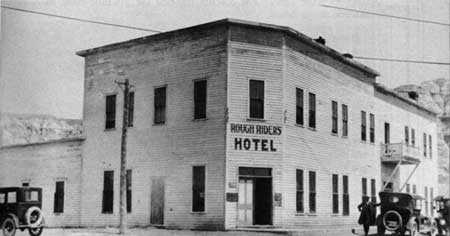
Rough Rider's Hotel in Medora, originally the
Metropolitan Hotel. Courtesy Osborn Studios.
6. Rough Rider Hotel. This two-story building, constructed in 1885 as the Metropolitan Hotel, has been restored by the Gold Seal Company. It is operated in the summer months.
7. St. Mary's Church was built by the De Mores family in 1884.
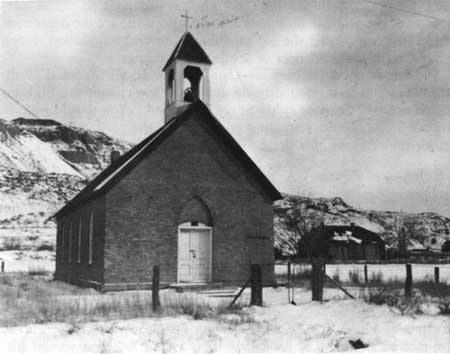
St. Mary's Church with Von Hoffman house on
right.
8. Von Hoffman House. Erected during the middle 1880's, it served as the residence of the Baron Von Hoffman, father-in-law of the Marquis de Mores and a prominent New York banker and financier. The building now houses a doll and toy museum. Admission is charged.
9. Chateau de Mores. This structure was erected in 1883 by the Marquis de Mores, and is now maintained by the State Historical Society. Many of the original furnishings are preserved here. An admission fee is charged.
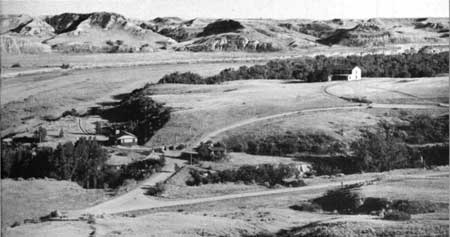
Chateau de Mores in upper right on benchland
overlooking the Little Missouri River.
10. Site of Little Missouri, located on the west side of the river of the same name. This town had its beginning in 1879 when the Northern Pacific Railroad reached this point. Eventually, Medora supplanted Little Missouri. By the end of the 19th century, the town had virtually disappeared.
11. Site of the Badlands Cantonment, located about three-fourths of a mile northwest of Medora. The Government established this one-company infantry post in 1879, but the army abandoned it in 1883. It then became an outfitting point for hunters.
12. Site of the Maltese Cross Ranch. A drive of about 10 miles over winding dirt roads south of Medora will bring you to the site of Roosevelt's first cattle venture. However, the cabin from this ranch is now located at the Visitor Center for the National Park, which is in Medora. You should inquire at the Visitor Center for specific directions to this site.
The cabin, which Roosevelt and his Maltese Cross foremen had occupied, was a story and a half structure with a high-pitched shingled roof. The side and end walls were made of railroad ties and pilings which a railroad contractor had vainly attempted to float down the Little Missouri. Not long after Sylvane Ferris purchased the cattle and ranch buildings from Roosevelt, he sold the cabin to J. F. Snyder, who proceeded to make drastic alterations in the old ranchhouse. He removed the high-pitched roof and the half-story, which had been used as a sleeping room, and converted the cabin into a one-story structure with a low, sloping roof. He covered the roof with dirt and "scoria"—a practice common in the Dakota Badlands at that time.
Fortunately, after Roosevelt became President, the State of North Dakota took steps to preserve the Maltese Cross Ranchhouse before it disappeared. The State purchased and dismantled the modified structure and shipped it to St. Louis where it was exhibited at the Louisiana Purchase Exposition. The old ranchhouse proved to be one of the most popular exhibits there. In the 1920's, the cabin, after being moved several times, was placed near the Liberty Memorial Building on the State Capitol grounds in Bismarck, until it's move to Medora.
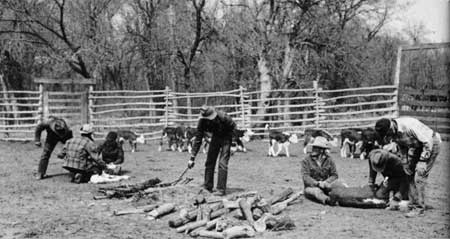
Branding Iron from Old Maltese Cross Ranch,
1954.

|

|
|
Last Modified: Sat, Jan 17 2004 10:00:00 am PDT |


